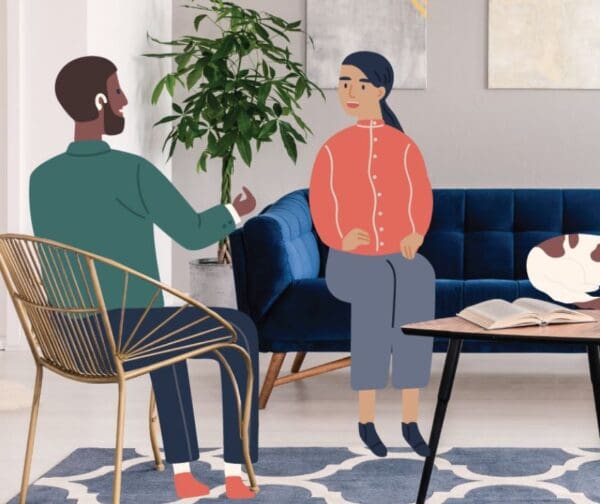
Tips for Being Deaf-Aware: Part 1
Communication is an essential part of life, but Deaf and hard-of-hearing people are often cut off from many forms of communicating that hearing people rely on. This can be frustrating and isolating.
The odds are that, even if you are hearing, you know and regularly interact with someone who has a significant hearing loss. The World Health Organization estimates that about 466 million people around the world have significant hearing loss, and that by 2050, that figure will nearly double. That will mean that one in 10 people will have significant hearing loss in the next 30 years.
There are easy ways that each of us can be a little more Deaf aware. This ranges from knowing more about Deaf culture to supporting the equal access that many deaf and hard-of-hearing people fight for.
A first step is simply being attentive to the ways you can effectively communicate with someone who is deaf or hard-of-hearing. Here are a few easy ways to do this.
1. Understanding Deafness
Deafness is a spectrum. If someone says they are deaf, they are not necessarily ‘profoundly deaf’ (meaning they can’t hear anything at all). They might not be able to hear anything at all, or they might be able to hear conversation fairly well, or any variation in between. Degrees of hearing loss vary dramatically from person to person. Some people may also wear hearing aids or cochlear implants.
Communication styles
Each deaf or hard-of-hearing person will also have different ways of communicating. They might include a sign language (of which there are many!), lip-reading, the use of an interpreter, a combination of all of these, or none of these. Some deaf or hard-of-hearing people might hear to a degree that they can listen to a conversation and respond directly.
Environmental factors might also come into play. It may be harder for a deaf or hard-of-hearing person to make out sounds and words in a noisy environment, so even if they can hear you in a quiet environment, they might need to use alternative communication methods in a noisier area.
Deaf as an identity
It’s also important to understand deafness as an identity. ‘Deaf’ with a capital ‘D’ refers to a cultural identity, which many people take pride in, while ‘deaf’ with a lower-case ‘d’ simply refers to a degree of hearing loss in practical terms. Many Deaf people do not consider deafness to be a disability, but some do.
2. The Signs that Someone Can’t Hear You
Often, you might not realize that someone is deaf or hard-of-hearing. Here are some signs that may help you notice. Someone may:
- Ask you to repeat phrases or words
- Seem confused while in conversation
- Appear to be ignoring you
- Pay close attention to your facial expressions
- Communicate with hand gestures that you don’t understand
- Be wearing a hearing aid or cochlear implant
3. Getting Someone’s Attention
If someone is deaf or hard-of-hearing, yelling “Hey you!” across a noisy room isn’t going to work. Neither is whistling. Of course, it’s also not likely to be a welcome greeting by anyone.
If you suspect someone is deaf or hard-of-hearing, you can move into their field of vision to get their attention. Alternatively, a friendly wave can let them know you are interested in a chat. Whichever way you choose, make sure you have a warm smile and are actively seeking eye contact.
4. Body Position is Important
Body positioning is also critical. Face the person, and, if at all possible, be at the same eye level. For example, stand if they are standing; sit if they are sitting. And don’t forget to make and maintain eye contact.
5. Speak in a Clear, UNexaggerated Way
Many deaf or hard-of-hearing people expend a lot of energy to communicate and follow conversations with hearing people. Lip-reading is one way a deaf or hard-of-hearing person may strive to keep up, but lip-reading is difficult. Even the best lip-readers on average understand only 30 per cent of what is being said. Add a mustache or accents, and lip reading becomes even harder.
Trying to exaggerate your words and drastically slow down the way you pronounce words does not help a deaf or hard-of-hearing person to understand you. It distorts the words and makes it much more difficult for someone to follow you.
Do:
- Speak clearly, slowly and steadily. Don’t mumble, shout or exaggerate.
- Be positioned with good lighting to allow the person to follow your lip movements.
- Make sure your mouth is uncovered.
6. Use Simple Body Language and Visual Cues
When speaking, a few simple gestures can help you get your point across. Of course, don’t go overboard trying to mime every single word. This can come across as disrespectful, not to mention distracting.
7. Writing to Communicate
Also, don’t be afraid to use pencil and paper, or a text app on your phone, to supplement your communication if necessary. A deaf person may prefer writing, and it’s important to be flexible to each person’s needs.
Everyone is different
When in doubt of how best to communicate with someone who is deaf or hard-of-hearing, just ask the person for suggestions to improve communication! They want to communicate with you as much as you do and are working much harder.
Read more about the ways we can all become more deaf-aware in part two of this series.
Visit Ai-Media’s website to find out more about our range of accessibility services, covering captioning, translation and transcription.


